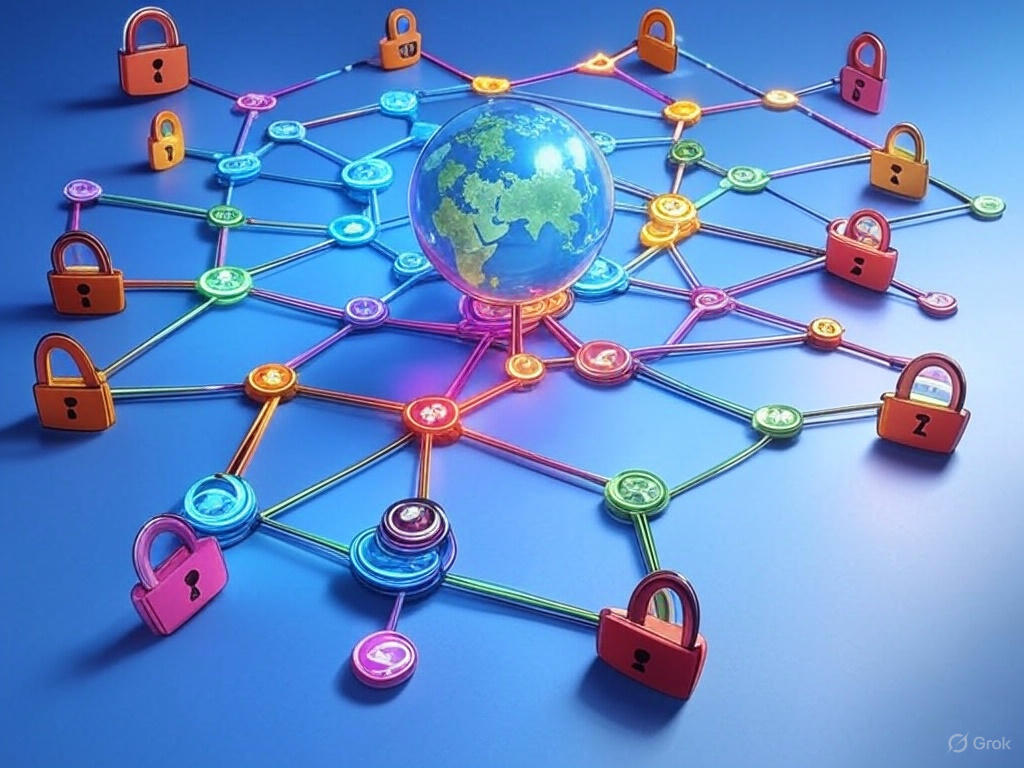What is the main purpose of blockchain? Unlock the main value #DecentralizedRevolution #ImmutableTrust #CryptoBackbone #TransparentChain #BlockchainEssence #SecureDataFuture #PeerToPeerPower #LedgerOfTruth #BlockchainBlueprint #DecentralizedDream #CryptoTrustSystem #NodeNetworkMagic #FutureOfTrust #BlockchainVisionArt
What is the main purpose of blockchain? Unlock the main value

Blockchain technology has taken the world from the storm, which is often associated with Cryptocurrency as Bitcoin. But actual capacity extends more than digital coins. In your heart, blockchain provides a basic purpose: to enable safe, transparent and decentralized data management. This article examines the main goal of blockchain, its transformative applications, and why it means something in today's digital age - all in an attractive and accessible way.
Blockchain's main goal
The main purpose of blockchain is to provide a reliable, decentralized system for registration and sharing that is safe,

The main purpose of blockchain is to provide a reliable, decentralized system for registration and sharing that is safe,
transparent and tampering proof. Unlike traditional systems, which rely on a central authority
(such as bank or authorities), data distributes to a network of blockchain computers, and ensures that no device is
checked. It creates faith through technology rather than intermediaries.
Here are some missing how blockchain achieves this goal:

Decentralization: Data is stored on many nodes (computers) all over the world.This removes the need for a boss or
central control and makes cheating or system failure less likely.
Openness: Each transaction or data registration on a public blockchain appears to all participants and promotes accountability.
Change: When data is registered on blockchain, it is almost impossible to replace them without agreement from the
network to ensure integrity.
Security: Cryptographic algorithms protect data, making it very resistant to hacking or unauthorized changes
In essence, blockchain acts as a digital ledger that ensures trust in environments where parties may not inherently trust each other—whether it's for financial transactions, contracts, or data sharing.
How does your Blockchain fulfill your purpose?
The design of blockchain that is particularly beneficial for solving real world problems where trust and security are crucial. Let's find out its purpose through the most important mechanisms: 1. Remove middlemen In traditional systems, middlemen such as banks or payment processors confirmed the transaction, and added possible times, costs and failure. Blockchain removes these middle men using the consensus mechanism (for example,

The design of blockchain that is particularly beneficial for solving real world problems where trust and security are crucial. Let's find out its purpose through the most important mechanisms: 1. Remove middlemen In traditional systems, middlemen such as banks or payment processors confirmed the transaction, and added possible times, costs and failure. Blockchain removes these middle men using the consensus mechanism (for example,
proof of work or proof for the share), where network participants collected data. For example, Bitcoin allows a bank without a colleague to pay payments, saves fees and enables rapid global transfer.
2. Inspire about data integrity
Blockchain - Exclaimer ensures that when the data is written, they cannot be changed without replacing all later blocks - a process that requires enormous calculation power on a large network. This makes blockchain ideal for maintaining
irreversible records, such as real estate title, medical history or voting results.
3. Increasing transparency and traceability
Public blockchains allow anyone to view the ledger, making the process transparent. In supply chain management, for example, blockchain can track a product's journey from origin to consumer, ensuring authenticity and preventing fraud. Companies like IBM use blockchain to trace food products, reducing the risk of contamination by quickly identifying
issues.
4. Enabling secure digital interactions
Blockchain uses cryptography to secure data, ensuring that only authorized parties can access or modify it. This is crucial for applications like digital identity verification, where individuals can control their personal data without relying on a central authority vulnerable to breaches.
Real-world applications of blockchain's purpose
Blockchain's ability to build trust in a decentralized manner has led to its adoption across diverse industries .Here are some examples:

Blockchain's ability to build trust in a decentralized manner has led to its adoption across diverse industries .Here are some examples:
- Finance: Beyond cryptocurrencies, blockchain powers decentralized finance (DeFi) platforms, enabling lending, borrowing, and trade without traditional banks.
- Supply chain: Walmart uses blockchain to track production, ensure food safety, and reduce waste by identifying inefficiencies.
- Healthcare: Blockchain secures patient records, allowing seamless sharing between providers while maintaining privacy.
- Smart contracts: On platforms like Ethereum, blockchain automates contracts that execute when conditions are met, such as releasing funds for a project upon completion.
- Voting systems: Blockchain can create transparent, tamper-free voting systems, reduce fraud, and increase trust in the electoral process.

Blockchain's purpose—to establish trust without intermediaries—addresses critical challenges in our digital world: Cost Reduction: By eliminating intermediaries, blockchain reduces transaction fees and operating costs. People Empowerment: Users have control over their own data and things, so they don't have to rely on big central companies. Fighting Fraud: Immutable records prevent tampering, making blockchain a powerful tool against corruption and
fraud.
Driving Innovation: Blockchain opens the door to new business models, such as tokenized assets or decentralized applications (dApps), driving creativity and economic growth.
While blockchain is intended to be transformative, it faces obstacles:
- Scalability: Large blockchains like Bitcoin can be slow and energy-intensive, limiting their ability to handle large transaction volumes.
- Adoption: Many industries are hesitant to adopt blockchain due to regulatory uncertainty or lack of
- Energy use: Methods like proof of work need a lot of energy, which can harm the environment.
Proof of Stake) are addressing these issues, ensuring that blockchain can fulfill its purpose more efficiently.
As blockchain technology matures, its purpose will continue to evolve.Emerging trends include:
- Interoperability: Blockchains are being connected to each other, allowing seamless data sharing across
- Sustainability: Greener consensus mechanisms are making blockchains more environmentally friendly.
- Massive adoption: Governments and corporations are looking to blockchain for everything from digital
The main goal of blockchain is to create a safe, transparent and decentralized system for handling data, which eliminates the need for middlemen who secure trust. From economics to the health care system, the applications convey how we interact in the digital world. While the challenges remain, the ability to strengthen people in blockchain, reduces costs and fight the scams to the foundation stone for future innovation. Embrace the opportunities, and you will see why blockchain is not just a discussion - it's a revolution in faith.

.jpg)


Comments
Post a Comment